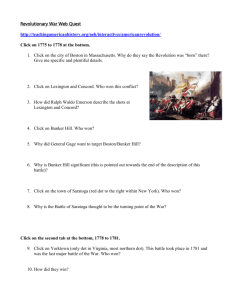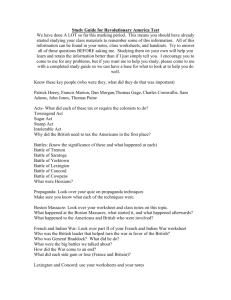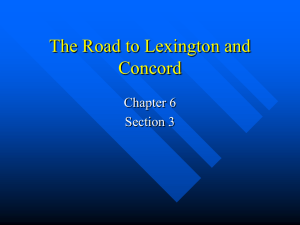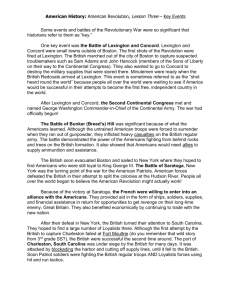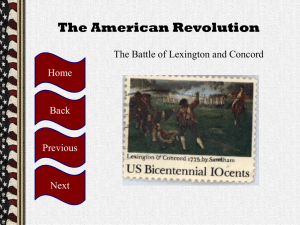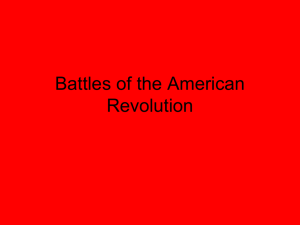TTT-Report-to-Texas-SBOE-on-McGraw-Hill-United-States
advertisement
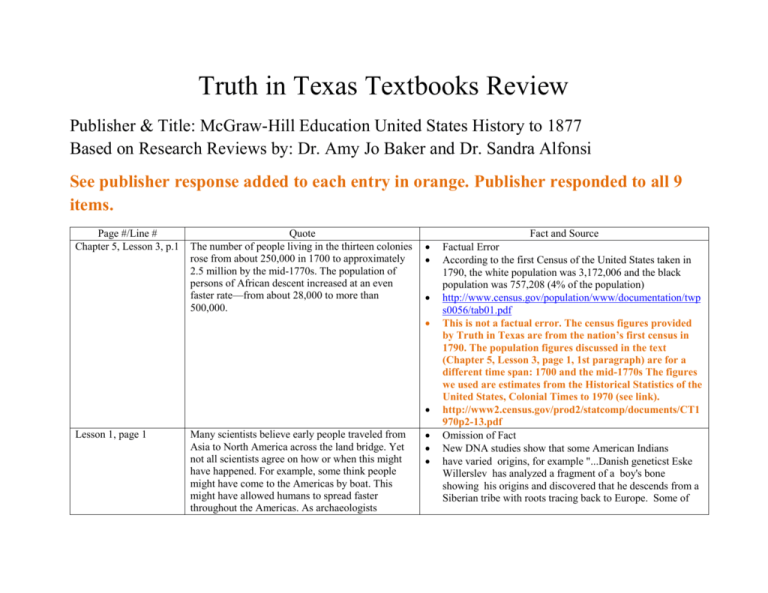
Truth in Texas Textbooks Review Publisher & Title: McGraw-Hill Education United States History to 1877 Based on Research Reviews by: Dr. Amy Jo Baker and Dr. Sandra Alfonsi See publisher response added to each entry in orange. Publisher responded to all 9 items. Page #/Line # Chapter 5, Lesson 3, p.1 Quote The number of people living in the thirteen colonies rose from about 250,000 in 1700 to approximately 2.5 million by the mid-1770s. The population of persons of African descent increased at an even faster rate—from about 28,000 to more than 500,000. Lesson 1, page 1 Many scientists believe early people traveled from Asia to North America across the land bridge. Yet not all scientists agree on how or when this might have happened. For example, some think people might have come to the Americas by boat. This might have allowed humans to spread faster throughout the Americas. As archaeologists Fact and Source Factual Error According to the first Census of the United States taken in 1790, the white population was 3,172,006 and the black population was 757,208 (4% of the population) http://www.census.gov/population/www/documentation/twp s0056/tab01.pdf This is not a factual error. The census figures provided by Truth in Texas are from the nation’s first census in 1790. The population figures discussed in the text (Chapter 5, Lesson 3, page 1, 1st paragraph) are for a different time span: 1700 and the mid-1770s The figures we used are estimates from the Historical Statistics of the United States, Colonial Times to 1970 (see link). http://www2.census.gov/prod2/statcomp/documents/CT1 970p2-13.pdf Omission of Fact New DNA studies show that some American Indians have varied origins, for example "...Danish geneticst Eske Willerslev has analyzed a fragment of a boy's bone showing his origins and discovered that he descends from a Siberian tribe with roots tracing back to Europe. Some of discover new artifacts and evidence, new theories emerge to challenge old ones. Ch1/Lesson1 & Lesson 2 May not have always been “steamy rain forest” for the Mayan; climate changes not accounted for the boy's ancestors are likely even to have lived in presentday Germany." Der Spiegel (www.spiegel.de/international/dna-analysiswhows-native-maeicans-had-european-roots-a954675.html The Montana boy’s 12,500 year old DNA fragment analysis showed the same results of the Siberia example. http://www.amren.com/news/2014/02/montana-boy-bonesshow-ancestral-links-to-europe/ This is a request for additional content. In Chapter 2, Lesson 1, page 2, paragraph 1, we describe the most common points of departure, the land and water routes (Siberia and the Bering Sea). We do not attempt to describe the point of origin for the earliest migrants. As noted in the Truth in Texas review, recent scholarship shows Europe as a point of origin. We note in the text [Chapter 2, Lesson 1] that, “As archaeologists discover new artifacts and evidence, new theories emerge to challenge old ones.” Omission of fact Evidence of abundant rainfall early in the Maya civilization and drought later could explain its fate, scientists suggest. http://articles.latimes.com/2012/nov/12/science/la-sci-mayaclimate-change-20121117 This is a request for additional material. In Chapter 2, Lesson 2, the text describes the decline: “In time the Maya civilization declined. By about 1200, its once-great cities were nearly deserted. The reason is a mystery. One theory holds that the soil became exhausted and unable to produce enough food for large populations.” Recent scholarship notes that the decline was one of many probable causes: “But today scientists generally agree that the Maya collapse has many roots, all intertwined— overpopulation, warfare, famine, drought. At the moment, the hottest field of inquiry centers on climate change, perhaps of the Maya's own doing.” “Widespread deforestation reduced the flow of moisture from the Ch 3/Lesson 2, 4 & 5 Discusses Muslim & Islam” - full discussions Lessons 3, 7, & 8 Uses the word “states” for the colonies – ground to the atmosphere, interrupting the natural rain cycle and in turn reducing precipitation.” Source: http://news.nationalgeographic.com/news/2012/11/12110 9-mayacivilization-climate-change-belize-science/ For clarification, we will add more possible reasons for the decline. We will delete: “The reason is a mystery. One theory holds that the soil became exhausted and unable to produce enough food for large populations.” And replace with: “Recent studies indicate that overpopulation, drought, and warfare are possible reasons for the Maya decline.” Irrelevant to topic North American development and history; No relation to Americas; what about German, etc.? This belongs in a World Geography; World History or Grade 6 book not US History. This is neither a factual error nor a full discussion of Islam. We do not see setting the context for what led to the exploration and colonization of the Americas, as irrelevant. European exploration and colonization, the Crusades, and the growth of trade include interaction with other cultures, including the Muslim culture. Islam had spread along the major trade routes of Asia, and Arab Muslims served as the middle men in trade between Europe and China and India. When conflict interrupted trade during the Crusades, European explorers and sailors searched for other routes, leading eventually to the exploration and colonization of the Americas. Discussion of the Muslim world in the text is within the context of these historical events. Factual Error they were not states at this time We are unclear about the reference; our programs do not have 7 or 8 lessons. Our text refers to ‘states’ or ‘former colonies’ after the signing of the Declaration of Independence. The Declaration states [end of Chapter 6] Ch 7/Lesson 2 Does not mention battles of Lexington or Concord – does not mention Paul Revere (except at a side reference to a former slave’s ride) No mention of Battle of New Orleans that, ”as Free and Independent States, they have full Power to levy War . . . and to do all other Acts and Things which Independent States may of right do.” This document announced that the thirteen American colonies were no longer part of Great Britain and should regard themselves as thirteen newly independent sovereign states. Omission of critical facts This is not an omission; the reviewer overlooked this content. The battles of Lexington and Concord are described in detail in Chapter 6, Lesson 3. The first paragraph reads: “Meanwhile, the British continued their march. At dawn, the redcoats approached Lexington. There they ran into about 70 waiting minutemen. Led by Captain John Parker, the minutemen stood on the town common with muskets in hand. Badly outnumbered, the minutemen were about to give way to the redcoats. Just then, a shot was fired— from where is still not clear. Both sides let loose an exchange of bullets. When the shooting ended, eight minutemen lay dead.” Following the paragraphs describing the battles, a final paragraph reads: “About 60 years later, poet Ralph Waldo Emerson wrote in "The Concord Hymn" that the Americans at Lexington and Concord had fired the "shot heard 'round the world.’ The battle for independence had begun.” An accompanying map in the section shows the movement of the British troops and the colonial militia to Lexington and Concord. The map also shows the route taken by Paul Revere during his ride. The Battle of New Orleans is discussed in Chapter 11, Lesson 4. The battle (also pictured in a painting) is described as the final battle of the War of 1812 and a decisive victory for the Americans. Also noted is that the battle made Andrew Jackson a national hero. Ch 9/Lesson 2 The text does not discuss the basis for the President being the Commander in Chief of the military – civilian control of military Ch 9/Lesson 2 Does not mention that members of the courts (judiciary) are nominated by the Pres, must be approved by the Senate – another check and balance Throughout Chapter 18 Robert E. Lee and Stonewall Jackson are the only Southern Generals given any mention. Omission of critical facts This is a request for additional content. We agree to clarify the basis of civilian control of military. In the annotated Constitution, Article II, Section 2, under “Presidential Powers,’ we will insert the following: “The Constitution places the military under the control of the president, a civilian. The Framers realized that, if military force was not controlled, it could endanger the nation.” Omission of critical facts This is not an omission of facts. The diagram, “A System of Checks and Balances” (Chapter 9, Lesson 1), states that the President can appoint judges and that the legislative branch can reject appointments. Stated in Chapter 9, Lesson 2: “Members [of the Supreme Court] are nominated by the president and approved by Congress.” Omission of critical facts This is not an omission of facts. In addition to Robert E. Lee and Stonewall Jackson, other Confederate generals are identified in Chapter 18 and their roles in the conflict are described. These generals are: P.G.T. Beauregard (Lesson 2, First Battle of Bull Run and Shiloh); Albert Sidney Johnson (Lesson 2, Shiloh); George Pickett (Lesson 4, Gettysburg); and John Hood (Lesson 5, Atlanta).

